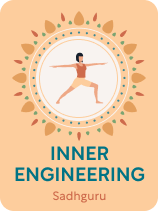

This article is an excerpt from the Shortform book guide to "Inner Engineering" by Sadhguru. Shortform has the world's best summaries and analyses of books you should be reading.
Like this article? Sign up for a free trial here.
What exactly is yoga beyond a form of exercise? How does the Western world misunderstand the concept of yoga?
The Western understanding of the concept of “yoga” does not reflect its true meaning. According to renowned yogi master Sadhguru, yoga is so much more than a means of getting fit.
Here are some common misconceptions of yoga in the Western world, according to Sadhguru.
What Yoga Is Not
To get an accurate understanding of yoga, we need to first recognize that people in the Western world tend to misunderstand it. What we think of as yoga is just one of the many forms, Sadhguru explains—and even that form we tend to misunderstand.
1. Yoga is not exercise, or a means for getting “fit.” The yoga we’re most familiar with in modern Western cultures, involving stretching postures, is hatha yoga. But people tend to focus only on the physical part of it. Sadhguru says that’s totally inefficient because the physical and spiritual must work together. If you do it for “exercise,” it’ll still bring you some benefit, but not as much as if you understand the real purpose and intentionally use it for a mind-body transformation.
2. Yoga is not an end goal in itself. Hatha yoga is the science of aligning your body with the energy of the universe. Hatha is meant to be a preparatory practice for a bigger (spiritual) goal, not an end in itself. For example, long periods of meditation require your physical body to be in good shape, so you can sit comfortably. Successful meditation practice therefore requires getting the body in shape. Flexibility is also not the goal. But Sadhguru says your body posture both affects and reflects your state of consciousness. So this form of yoga uses body postures intentionally to elevate your consciousness. He says your body is like an antenna—how you hold it determines the reception you get.
3. Yoga is not a religion or a belief system. Sadhguru emphasizes that this book does not offer any doctrine or belief system to follow. It simply allows you to understand the mechanism by which you can transform your life. According to Sadhguru, yoga is about a radical self-transformation, involving a fundamental shift in the way you perceive life. And he stresses that none of it needs to be taken on faith. It’s all testable and experiential.
Even “spirituality” doesn’t refer to anything supernatural, according to Sadhguru. He says religion as a whole is totally unnecessary. “Divine love” and “god” are not something in a faraway supernatural realm—they’re part of us, accessible inside of all of us. Likewise, “eternal life” or “heaven” are not something relegated to an afterlife—we have access to eternity just by getting in touch with that infinite dimension of life. We need to realize that the “divine” is very real, but it’s all natural and part of us as humans.
4. Yoga is not exclusive or unattainable. Spiritually, Sadhguru says everyone is equal, and therefore equally capable of transforming through yogic practices. You don’t need to retreat to a cave. You only need to spend a few minutes a day enhancing your awareness of your internal state.
| Is Practicing Yoga Cultural Appropriation? Some have argued that the adoption of yoga en masse by Westerners constitutes cultural appropriation. This argument is based on the claim that removing yoga from its cultural and spiritual context for the benefit of a dominant culture is inherently disrespectful. Part of the problem may lie in these misunderstandings explained by Sadhguru. As Sadhguru says, yogic tradition is clear that yoga is not exclusive to any group of people, but is available to everyone regardless of background or demographic. And since he also explains that yoga doesn’t rely on a specific spiritual or religious belief system, then this means that non-Indian or non-Hindu people practicing yoga can’t be inherently problematic. That would also directly contradict the core yogic teaching of the oneness of everything. So, charges of cultural appropriation rely more on the oversimplified understanding of it by Western practitioners. Approaching yoga as a means for getting fit, as an end goal in itself, or even as a trendy subject for social media photos disregards the complexity and richness of a deeply meaningful philosophy and practice with roots in ancient history. When those who are guilty of such oversimplification are also financially profiting from it, the problem is amplified into one of more clear-cut appropriation. |
What Yoga Is
Now that we understand what yoga is not, what is it? According to Sadhguru, yoga is a tool for developing self-mastery, allowing you to consciously create your experience of life. Through it, you can experience union with the energy of the universe and eliminate your fear of suffering and concern about self-preservation—in other words, you can enjoy living and stop worrying about dying. When these fears are gone, you can experience life fully and be fine in any situation.
This self-mastery must happen on multiple levels. Sadhguru explains that according to yogic philosophy, we’re composed of five layers, or “bodies”:
- The physical body (often called the “food body” in yogic terminology)
- The mental body (your thoughts and emotions)
- The energy body (how your energy flows through you)
- The etheric body (extraordinary knowledge accessed through transcendental states)
- The bliss body (a state of enlightenment)
Sadhguru says you only need to work with the first three layers. The final two are not accessible until you’ve worked with the first three, and once you’ve done that work, they’ll naturally follow. So all the instructions in this book are for obtaining mastery over your body, mind, and energy.
Yoga as a whole is the combination of methods for improving the condition of your body, mind, and energy. We will take an in-depth look at each.
| The Many Variations of Yoga There are several types and sub-types of yoga, developed by many different teachers over the years. While the classifications and descriptions of yoga styles vary widely from one source to another, they can generally be differentiated based on what aspect, or “body,” they address. A few of the more common forms include: Hatha: Hatha yoga is a broad category, including many sub-types, that deals with the physical body. This is the most common form of yoga practiced in the West and includes such styles as Vinyasa, Iyengar, Ashtanga, and Bikram (or “hot” yoga). Bhakti: Bhakti yoga is defined by Sadhguru as the yogic path of devotion. The goal of this form of yoga is union with the divine, which is reached through the emotional part of your mental body. It involves channeling all of one’s emotions into a deep love for “god” or whatever deity or spiritual reality one is devoted to. Jnana: Also spelled “gnana,” this type of yoga is the path of knowledge or wisdom, and therefore deals with the thought portion of your mental body. The goal of this style of yoga is deep intellectual inquiry and analysis into life until one can realize ultimate truths through the mental process. Kriya: Kriya yoga deals with transforming the energy body. It involves breathwork to transform the flow of energy through your body, with the goal of reaching a higher state of consciousness. Kriya yoga practices would look more like what we tend to think of as “meditation,” and if they’re seriously undertaken they can result in mystical or transcendental experiences. Kundalini: Kundalini yoga is sometimes classified as a type of hatha yoga because it involves physical body postures. But as it also deals with raising one’s energy with the goal of attaining a higher consciousness, it can be seen as a combination of some of the other types. |

———End of Preview———
Like what you just read? Read the rest of the world's best book summary and analysis of Sadhguru's "Inner Engineering" at Shortform.
Here's what you'll find in our full Inner Engineering summary:
- An introduction to the science of yoga and its transformative powers
- Renowned yogi Sadhguru's journey of self-discovery
- Why yoga is not meant to be an exercise or a way to get "fit"






